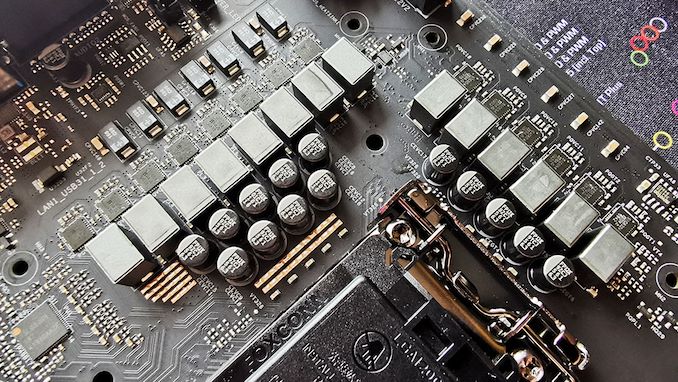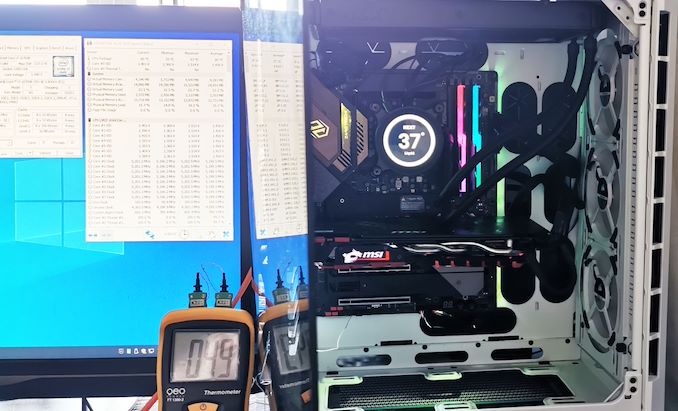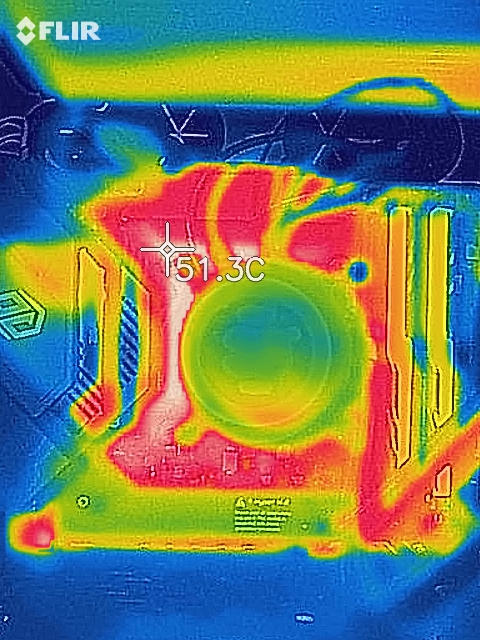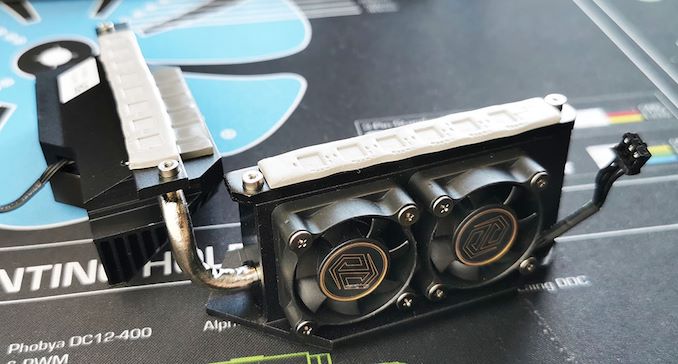The ASRock Z490 Taichi Motherboard Review: Punching LGA1200 Into Life
by Gavin Bonshor on May 27, 2020 9:00 AM ESTPower Delivery Thermal Analysis
A lot more focus has been put onto power delivery specifications and capabilities, not just by manufacturers, but as a result of users demands. In addition to the extra power benefits from things like overclocking, more efficient designs in power deliveries and cooling solutions aim to bring temperatures down. Although this isn't something most users ever need to worry about, certain enthusiasts are bringing more focus onto each boards power delivery. The more premium models tend to include bigger and higher-grade power deliveries, with bigger and more intricate heatsink designs, with some even providing water blocks on ranges such as the ASUS ROG Maximus Formula series.

The 12+2 (6+1) power delivery on the ASRock Z490 Taichi
Testing Methodology
Our method of testing out if the power delivery and its heatsink are effective at dissipating heat, is by running an intensely heavy CPU workload for a prolonged method of time. We apply an overclock which is deemed safe and at the maximum that the silicon on our testbed processor allows. We then run the Prime95 with AVX2 enabled under a torture test for an hour at the maximum stable overclock we can which puts insane pressure on the processor. We collect our data via three different methods which include the following:
- Taking a thermal image from a birds-eye view after an hour with a Flir Pro thermal imaging camera
- Securing two probes on to the rear of the PCB, right underneath CPU VCore section of the power delivery for better parity in case a probe reports a faulty reading
- Taking a reading of the VRM temperature from the sensor reading within the HWInfo monitoring application
The reason for using three different methods is that some sensors can read inaccurate temperatures, which can give very erratic results for users looking to gauge whether an overclock is too much pressure for the power delivery handle. With using a probe on the rear, it can also show the efficiency of the power stages and heatsinks as a wide margin between the probe and sensor temperature can show that the heatsink is dissipating heat and that the design is working, or that the internal sensor is massively wrong. To ensure our probe was accurate before testing, I binned 10 and selected the most accurate (within 1c of the actual temperature) for better parity in our testing.
To recreate a real-world testing scenario, the system is built into a conventional desktop chassis which is widely available. This is to show and alleviate issues when testing on open testbeds which we have done previously, which allows natural airflow to flow over the power delivery heatsinks. It provides a better comparison for the end-user and allows us to mitigate issues where heatsinks have been designed with airflow in mind, and those that have not. The idea of a heatsink is to allow effective dissipation of heat and not act as an insulator, with much more focus from consumers over the last couple of years on power delivery componentry and performance than in previous years.

ASRock Z490 Taichi undergoing our VRM thermal testing (we close the side panel when testing)
For thermal image, we use a Flir One camera as it gives a good indication of where the heat is generated around the socket area, as some designs use different configurations and an evenly spread power delivery with good components will usually generate less heat. Manufacturers who use inefficient heatsinks and cheap out on power delivery components should run hotter than those who have invested. Of course, a $700 flagship motherboard is likely to outperform a cheaper $100 model under the same testing conditions, but it is still worth testing to see which vendors are doing things correctly.
Thermal Analysis Results

We measured 51.3°C on the hottest part of the PCB around the power delivery
The ASRock Z490 Taichi is using a 12+2 phase power delivery which is controlled by an Intersil ISL69269 PWM controller operating at 6+1. The power delivery is using twelve Vishay SIC654 50 A power stages for the CPU, with six ISL6617A doublers, while the SoC section is using two Vishay SIC654 50 A power stages and a single ISL6617A doubler.

The ASRock Z490 Taichi uses an actively cooled VRM heatsink
Keeping the power delivery cool, ASRock has integrated a pair of small cooling fans designed to push airflow through the aluminium fins on the heatsink. ASRock has given the user full control over fan curves and settings for these fans, which when left on the original BIOS (1.30A) it came with, we're very noticeable in terms of noise levels. ASRock has since patched this via a firmware update (1.50) and opted for a more subtle and less aggressive fan curve which balances out heat versus noise levels.
Using our VRM thermal testing methodology, the ASRock Z490 Taichi performs well which is expected due to the actively cooled VRM heatsink. As the ASRock Z490 Taichi doesn't include a dedicated temperature sensor for the power delivery, we were at the mercy of our probes which outputted temperatures of 49°C on the first probe, and 48°C on the second. Taking the tempered glass panel off our test chassis and taking a thermal image, we observed a maximum of 51.3°C on the hottest part of the motherboard, which was in the corner between the CPU and SoC sections of the power delivery. Compared directly to the GIGABYTE Z490 Aorus Master which ran marginally cooler, albeit, with an 8+1 design, we expect the Z490 Taichi power delivery to run a little warmer when the two cooling fans are disabled.











57 Comments
View All Comments
lmcd - Wednesday, May 27, 2020 - link
Honestly this is the most inane post I've ever read. Times haven't changed for the better, Raven Ridge support took over a year after the SoC was released. I own two Raven Ridge devices. I would know.Even when AMD support hits mainline, it's in such a late kernel version that you better hope this "sane" distro you're referring to is willing to backport support in an update.
Dunno what you mean about the Nvidia driver being painless to use. Its Wayland support is still comparatively unstable in Gnome and pushes KDE Wayland support from mediocre to bad. It also requires extra build tools.
I can't edit posts but I explained a key usage of nested Hyper-V. "Anyone who wants to use the Windows 10X emulator needs it unfortunately." There's also plenty of other features that use Hyper-V these days from WSL2 to Windows Sandbox, so the antiquated views on Hyper-V are also quite dated. Times have changed for the better, and Hyper-V is very much part of the present.
Congrats on your condescension though! It almost masks how wrong you are.
Dug - Wednesday, May 27, 2020 - link
Why in the world do you insist on benchmarking Non-UEFI POST Time when no one will use that?TheinsanegamerN - Thursday, May 28, 2020 - link
Because not everyone is you and there are those of us that DO use it. Wow, what an amazing thought.Dorkaman - Thursday, May 28, 2020 - link
I would love to see UEFI post time AND Windpows clean knstall boot time. My old Asus Rampage V Extreme was very slow (40s post+boot no mem test hybrid) and the new Asus ROG Maximus XII Extreme is also very slow.My Gigabyte Z390 Aorus Master posts+boots in 10+5 seconds.
Dug - Wednesday, June 3, 2020 - link
Why would you be buying new equipment for outdated OS's that aren't supported?If that's the case, the boot time is irrelevant, and my post still stands. Why even bother benchmarking it?
Ranger1065 - Wednesday, May 27, 2020 - link
A good read, always a pleasure to peruse Anandtech. The aesthetics are not for everyone but personally I think it's a nice looking board. Out of my price range but Z490 is not for me anyway. As to Asus boards, I have an older Z97 Maximus Hero VII and a Z390 Prime. Both great boards that have given me no significant issues.Jorgp2 - Wednesday, May 27, 2020 - link
Do the new CPUs have an additional 4x lanes from the CPU?I keep seeing boards that advertise 8,8,4 slots, with all of them coming from the CPU. And this motherboard for example that has the 4x gen 4 M.2, when the chipset does not have Gen 4
MDD1963 - Wednesday, May 27, 2020 - link
The specs I read said the top GPU slot would be capable of PCI-e 4.0 x16, ...and one of the M.2 slots...( perhaps I missed where it said all 4 might be capable fo PCI-e 4.0 x4 operation?_)Even with the aforementioned limits, more than enough for 99% of most folks....
Spunjji - Thursday, May 28, 2020 - link
Waiting to see how many people show up to the comments to wail about the tiny fans. After all, it wasn't anti-AMD sentiment that caused so many folks to show to all of the articles related to X570 boards (and a few that weren't) and do that, it was totally neutral concerns about longevity and noise.(Full disclosure - I am fully on-board with not wanting tiny fans on a motherboard... just feeling a little amused by the asymmetry of this. The only comment here so far on this topic has been a sensible one, not hysterical ranting.)
TheinsanegamerN - Thursday, May 28, 2020 - link
So you smugly, disingenuously re-categorize the arguments of others and think you're...clever? Funny? Intelligent?Now, here's points for asrock that might blow your mind, these are STANDARD FANS. You can go buy brand new noctuas to replace these and silence them while maintaining cooling performance. Guess what you couldnt do with x570 chipset fans? These fans also dont spin 24/7, only when needed, and the VRMs here get a LOT hotter then the x570 chipset did.
If X570 got into the 90C range without the active cooling (it doesnt) and they used standard 40mm fans (they dont) then the complaints would be baseless. But we saw how necessary those x570 fans really were. And oh hey, there are plenty of Z490 mtoherboards that dont use VRM fans! Just like that whole 1 X570 motherboard that cost like $700!